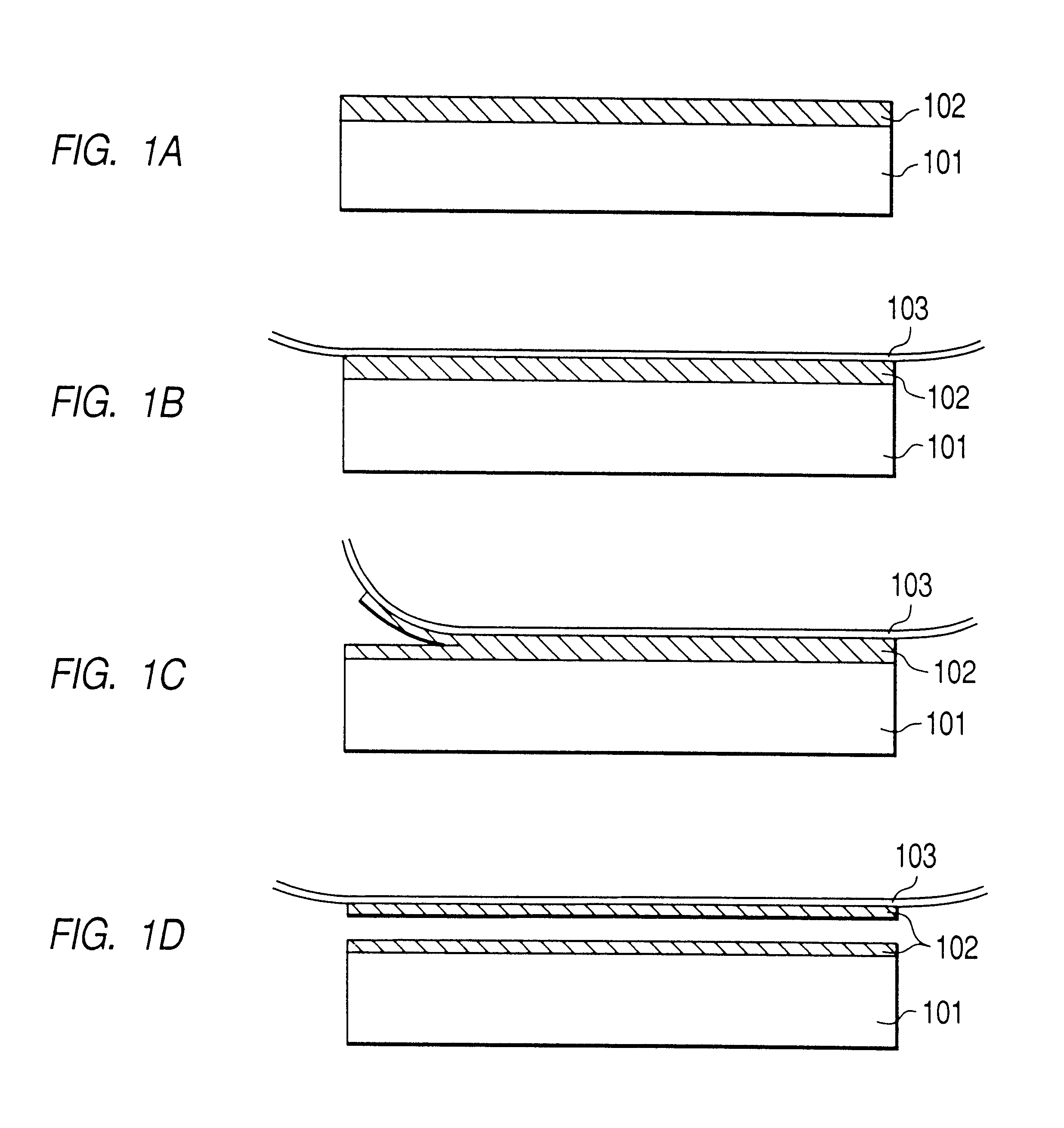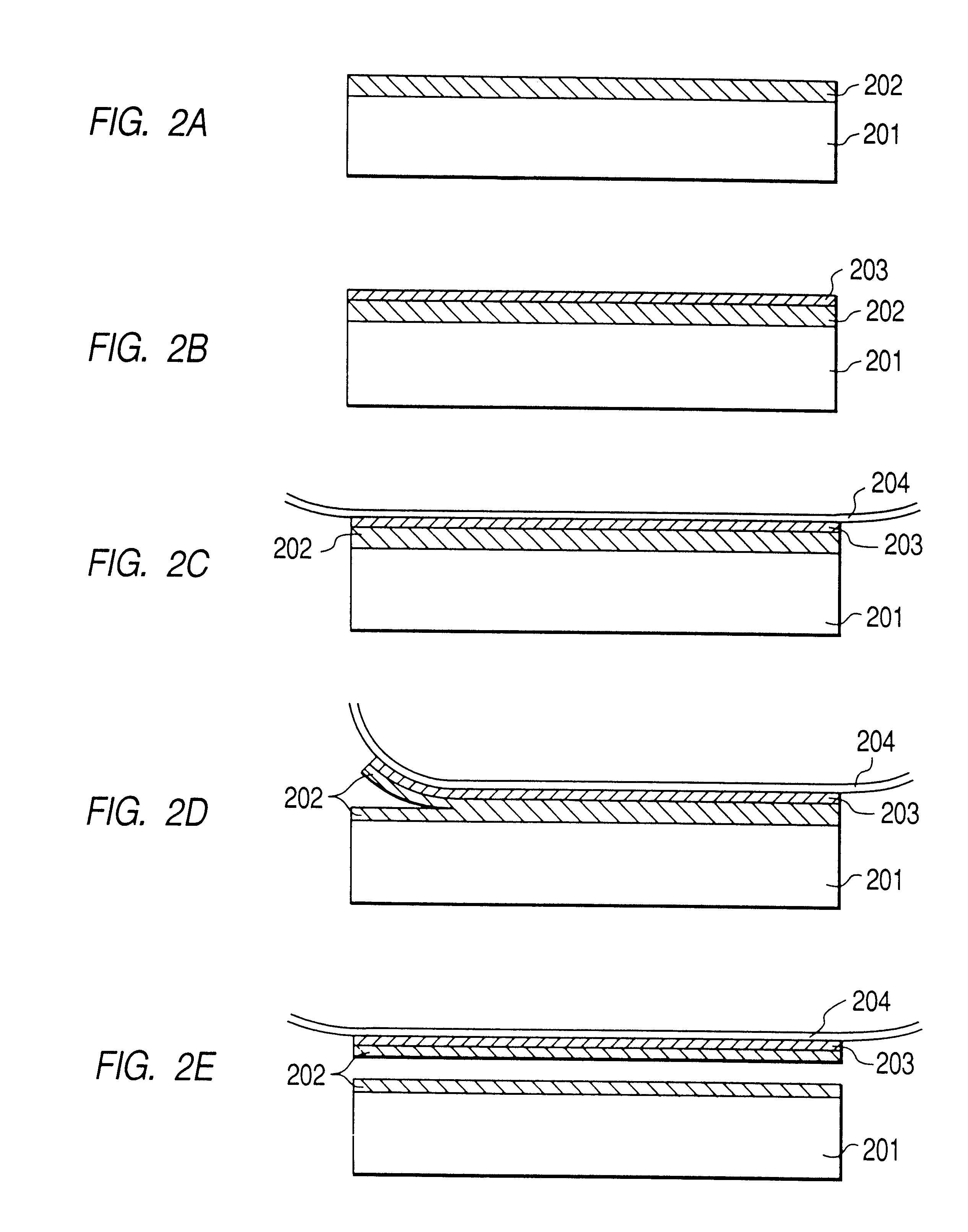Process for producing semiconductor article
- Summary
- Abstract
- Description
- Claims
- Application Information
AI Technical Summary
Benefits of technology
Problems solved by technology
Method used
Image
Examples
example 2
The surface layer of a monocrystalline Si wafer substrate was anodized in HF solution, under the following conditions:
current density: 7 (mA / cm.sup.2)
anodizing bath: HF:H.sub.2 O:C.sub.2 H.sub.5 OH=1:1:1
time: 11 minutes
porous Si thickness: 12 .mu.m
Then the substrate was oxidized for 1 hour at 400.degree. C. in oxygen atmosphere, whereby the internal wall of pores in the resulting porous Si layer was covered with a thermal oxidation film. Then, on the porous Si, monocrystalline Si was epitaxially grown, with a thickness of 0.15 .mu.m, by CVD (chemical vapor deposition) under the following conditions:
source gas: SiH.sub.2 Cl.sub.2 / H.sub.2
gas flow rate: 0.5 / 180 l / min.
gas pressure: 80 Torr
temperature: 950.degree. C.
growth rate: 0.3 .mu.m / min.
Then an adhesive film (peeling tape No. BT-315 supplied by Nitto Denko Co., Ltd.) was applied to the surface of the monocrystalline Si, then the rear face of the substrate was fixed to a vacuum chuck, and the adhesive film was then peeled off from ...
example 3
The surface layer of a monocrystalline Si wafer substrate was anodized in HF solution, under the following conditions:
current density: 7 (mA / cm.sup.2)
anodizing bath: HF:H.sub.2 O:C.sub.2 H.sub.5 OH=1:1:1
time: 4 minutes
porous Si thickness: 4.5 .mu.m
followed by:
current density: 30 (mA / cm.sup.2)
anodizing bath: HF:H.sub.2 O:C.sub.2 H.sub.5 OH=1:1:1
time: 1 minute
porous Si thickness: about 4 .mu.m
Under these conditions, there was formed a porous Si layer with two-layer structure of different porosities. In this anodizing with the current density of 30 mA / cm.sup.2, there was formed a structurally fragile porous Si layer with larger porosity.
Then the substrate was oxidized for 1 hour at 400.degree. C. in oxygen atmosphere, whereby the internal wall of the pores in the porous Si layer was covered with a thermal oxidation film. Then, on the porous Si, a monocrystalline Si was epitaxially grown, with a thickness of 0.15 .mu.m, by CVD (chemical vapor deposition) under the following conditions:
s...
example 4
In the surface layer of a monocrystalline Si substrate with an unspecified resistivity, a high concentration P.sup.+ layer of a thickness of 5 .mu.m, constituting the high concentration impurity layer, was formed by a diffusion process. At the same time a high concentration P.sup.+ layer was formed also on the back surface. Then anodizing was conducted in HF solution from the top surface side of the high concentration layer, under the following conditions:
current density: 7 (mA / cm.sup.2)
anodizing bath: HF:H.sub.2 O:C.sub.2 H.sub.5 OH=1:1:1
time: 11 minutes
porous Si thickness: 12 .mu.m
The resulting porous Si layer had a two-layer structure, with the lower porous Si having a finer and fragile structure in comparison with the surface layer part.
Then the substrate was oxidized for 1 hour at 400.degree. C. in oxygen atmosphere, whereby the internal wall of the pores in the porous Si layer was covered with a thermal oxidation film. Then, on the porous Si, a monocrystalline Si was epitaxial...
PUM
 Login to View More
Login to View More Abstract
Description
Claims
Application Information
 Login to View More
Login to View More - R&D
- Intellectual Property
- Life Sciences
- Materials
- Tech Scout
- Unparalleled Data Quality
- Higher Quality Content
- 60% Fewer Hallucinations
Browse by: Latest US Patents, China's latest patents, Technical Efficacy Thesaurus, Application Domain, Technology Topic, Popular Technical Reports.
© 2025 PatSnap. All rights reserved.Legal|Privacy policy|Modern Slavery Act Transparency Statement|Sitemap|About US| Contact US: help@patsnap.com



